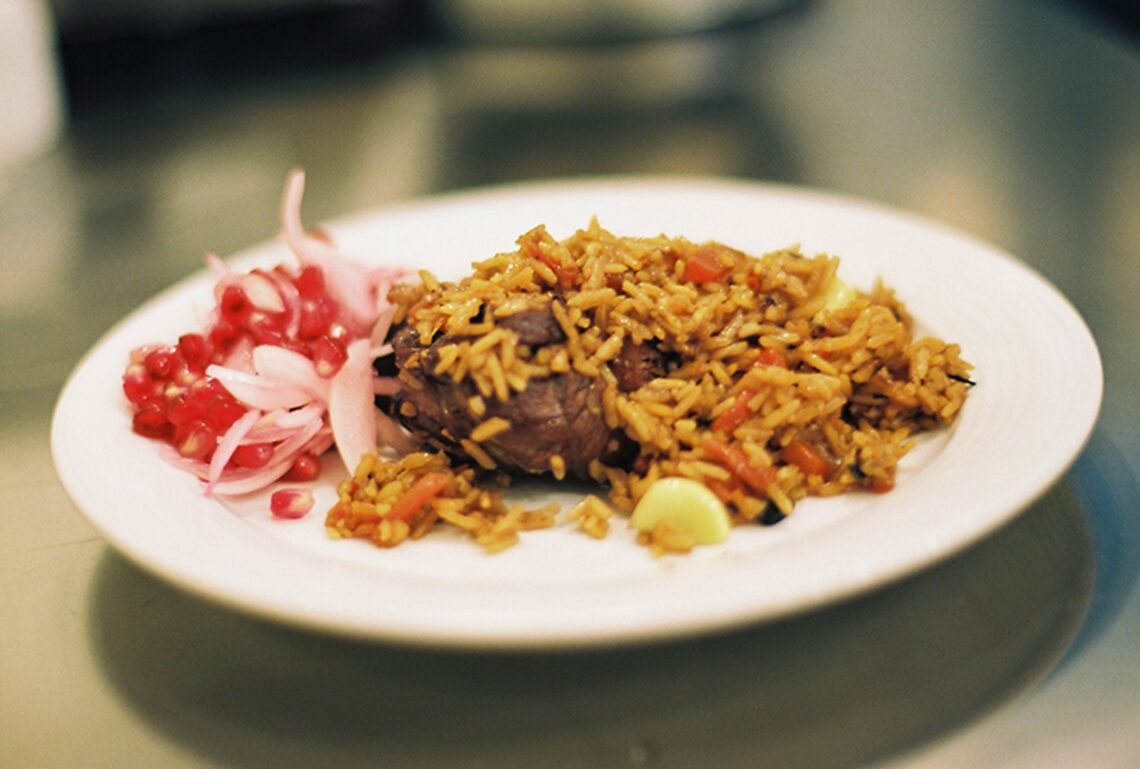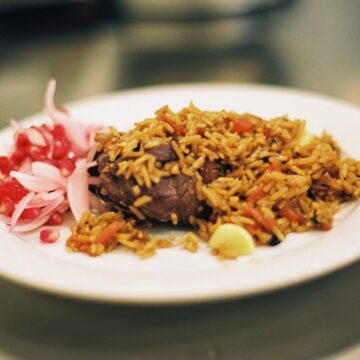As Khakim Ganiev, a person whose pilaf I have dreamed of trying for a long time, says: “The key in pilaf is a good company.” This dish ideally is eaten from a huge cauldron, so you can eat it with your fingers, lowering your hands there. If you eat with another person from the same cauldron, then you trust them. Pilaf is food that shows how close you are. I am not suggesting that you eat this dish in the traditional way, but I do suggest you prepare it and eat it in good company.
- Prep time: 20 minutes
- Cook time: 1 hour 30 minutes
- Serves: 8
- Difficulty: medium
- Course: main course
- Cookware: casserole
- Cuisine: Uzbek
Ingredients
- 350 g medium fat lamb, coarsely chopped
- 350 g veal ribs, divided into individual ribs
- 300 g beef fat, peeled and chopped
- water
- 700 g rice
- 7 carrots, peeled, cut into strips
- 2 medium onions, peeled, finely chopped
- 5-6 whole garlic bulbs, cut the roots
- 200 ml oil, sunflower or cottonseed
- 5 g cumin
- 5 g barberry seeds
- freshly ground black pepper
- salt
Cooking method
Step 1
Soak the rice in warm salted water until it starts to turn white. Then rinse the rice under warm water (it may crackfrom cold) until the water becomes clear.
Step 2
Put beef fat into a cold casserole. Add half of oil and put on low heat. Melt the fat until greaves form. Pull out greaves with a slotted spoon, we don’t need them.
Step 3
Add the rest of the oil to the melted fat, increase heat to high, and cook until a slight haze appears over the oil. Put the meat and fry on all sides for 3-4 minutes until golden brown, without reducing the heat. Take out the meat. Add the onion and fry until golden brown. Then add carrots, salt, spices, and stir. Fry until the carrots are semi-soft. In a separate saucepan, bring water to a boil. Return the meat to the casserole and pour boiling water over everything until the water completely covers the ingredients in the casserole. Bring to boil, reduce heat so that the liquid continues to boil, and simmer for 30 minutes. While boiling, discard the foam from the broth.
Step 4
Add the rice to the casserole, gently level it. Through a slotted spoon, in order not to disturb the rice layer, pour boiling water so that the water is about 2-3 cm higher than the rice. Increase the heat to high and bring the pilaf to a boil. When water is the same level as rice, add garlic bulbs to the pilaf. Begin to gently stir the rice from the walls to the centre (not the entire pilaf), so that it is not overcooked from below, and does not remain tough on top. Gradually, the liquid will go under the rice. Therefore, it is also necessary to gradually reduce the fire: the less water, the less fire. Otherwise, the pilaf may burn. When the rice is cooked and not crunchy, remove the pilaf from the heat, cover and let it rest for 20-30 minutes. Serve with pomegranate salad.



My tips and tricks:
Any rice for pilaf needs to be soaked and rinsed, including pre-steamed rice. Soaking time directly depends on the hardness of the rice. Soft rice takes 30 minutes, and hard rice takes up to 2 hours. To rinse the rice, you need to use dishes that significantly exceed its volume. For example, for our amount of rice, we need at least 4 litres container. Fill the rice with warm water and run your hand through the rice in order to raise as much feculence as possible and wash it off with the water. Repeat this action until the water becomes clear.
- 350 g medium fat lamb, coarsely chopped
- 350 g veal ribs, divided into individual ribs
- 300 g beef fat, peeled and chopped
- water
- 700 g rice
- 7 carrots, peeled, cut into strips
- 2 medium onions, peeled, finely chopped
- 5-6 whole garlic bulbs, cut the roots
- 200 ml oil, sunflower or cottonseed
- 5 g cumin
- 5 g barberry seeds
- freshly ground black pepper
- salt
- Soak the rice in warm salted water until it starts to turn white. Then rinse the rice under warm water (from cold it may crack) until the water becomes clear.
- Put beef fat into a cold casserole. Add half of oil and put on low heat. Melt the fat until greaves form. Pull out greaves with a slotted spoon, we don't need them.
- Add the rest of the oil to the melted fat, increase heat to high, and cook until a slight haze appears over the oil. Put the meat and fry on all sides for 3-4 minutes until golden brown, without reducing the heat. Take out the meat. Add the onion and fry until golden brown. Then add carrots, salt, spices, and stir. Fry until the carrots are semi-soft. In a separate saucepan, bring water to a boil. Return the meat to the casserole and pour boiling water over everything until the water completely covers the content of the cauldron. Bring to boil, reduce heat so that the liquid continues to boil, and simmer for 30 minutes. While boiling, discard the foam from the broth.
- Add the rice to the casserole, gently level it. Through a slotted spoon, in order not to disturb the rice layer, pour boiling water so that the water is about 2-3 cm higher than the rice. Increase the heat to high and bring the pilaf to a boil. When water is the same level as rice, add garlic bulbs to the pilaf. Begin to gently stir the rice from the walls to the centre (not the entire pilaf), so that it is not overcooked from below, and does not remain tough on top. Gradually, the liquid will go under the rice. Therefore, it is also necessary to gradually reduce the fire: the less water, the less fire. Otherwise, the pilaf may burn. When the rice is cooked and not crunchy, remove the pilaf from the heat, cover and let it rest for 20-30 minutes. Serve with pomegranate salad.


 As Khakim Ganiev, a person whose pilaf I have dreamed of trying for a long time, says: “The key in pilaf is a good company.” This dish ideally is eaten from a huge cauldron, so you can eat it with your fingers, lowering your hands there. If you eat with another person from the same cauldron, then you trust them. Pilaf is food that shows how close you are. I am not suggesting that you eat this dish in the traditional way, but I do suggest you prepare it and eat it in good company.
As Khakim Ganiev, a person whose pilaf I have dreamed of trying for a long time, says: “The key in pilaf is a good company.” This dish ideally is eaten from a huge cauldron, so you can eat it with your fingers, lowering your hands there. If you eat with another person from the same cauldron, then you trust them. Pilaf is food that shows how close you are. I am not suggesting that you eat this dish in the traditional way, but I do suggest you prepare it and eat it in good company.